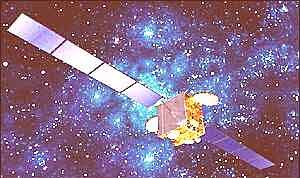ISRO to launch Indo-French weather satellite Megha Tropiques
03 Jan 2009
Close on the heels of the successful installation of India's unmanned lunar mission Chandrayaan-1 into orbit around Earth's solitary natural satellite and successfully crash landing the moon impact probe (MIP) on the lunar surface, the Indian Space Research Organisation (ISRO) is now planning to embark on a fresh mission to launch a weather satellite.
The ISRO plans to launch of the 'Mehga Tropiques', a weather satellite that is co-developed by the Indian and French space agency CNES (Centre National d'Etudes Spatiales). The mission of the satellite is to study tropical weather patterns and contribute to the study of cyclones, monsoons, and other climate and weather related phenomenon.
 According to the CNES website, the main objectives of the Megha-Tropiques mission are to provide simultaneous measurements of several elements of the atmospheric water cycle such as water vapour, clouds, condensed water in clouds, precipitation and evaporation; measure the corresponding radiative budget at the top of the atmosphere; and ensure high temporal sampling in order to characterise the life cycle of the convective system and to obtain significant statistics.
According to the CNES website, the main objectives of the Megha-Tropiques mission are to provide simultaneous measurements of several elements of the atmospheric water cycle such as water vapour, clouds, condensed water in clouds, precipitation and evaporation; measure the corresponding radiative budget at the top of the atmosphere; and ensure high temporal sampling in order to characterise the life cycle of the convective system and to obtain significant statistics.
Megha Tropiques is a mini-satellite using an Indian platform. ISRO chairman G Madhavan Nair was quoted in the media as saying that the satellite would be built by ISRO, with the French space agency adding a pair of onboard instruments called the SCARAB, a radiometer devoted to the measurement of outgoing radiative fluxes at the top of the atmosphere, and SAPHIR, a six-channels microwave radiometer for the retrieval of water vapour vertical profiles and horizontal distribution. A third onboard instrument is called the MADRAS, a microwave imager aimed mainly at studying precipitation and clouds properties.
Megha Tropiques ('Megha' being Sanskrit for clouds, and 'Tropiques' being French for tropics) is a 500 kilogramme satellite. The ISRO website pegged the proposed launch date for the project at around 2005, which means that the project would be delayed by almost four years by the time it lifts off in end-2009.
Megha Tropiques is dedicated to atmospheric and climate research in the tropics, and is to prove valuable to scientists working on global climate studies all around the world. The satellite would most probably be launched aboard a Polar Satellite Launch Vehicle (PSLV) from ISRO's launchpad at Sriharikota.
Megha Tropiques is expected to carry a multi-frequency microwave scanning radiometer (MADRAS) , a multi-channel microwave instrument (SAPHIR) providing humidity profile of the atmosphere and a multi-channel radiation instrument, ScaRaB, providing data on the earth's radiation budget.
The satellite's multi-frequency microwave and optical sensors would provide information on convective and cloud physical processes, water vapour and rainfall characteristics over ocean and land surfaces, monsoon radiation budget etc. It is proposed to have a unique 20 degree inclined orbit of 867 kilometres to provide maximum coverage of the tropical region of interest.
ISRO's website also said that changes in energy and water budget of the land-ocean-atmosphere systems in the tropics influence the global climate to a great extent, and Megha Tropiques would provide keen insights into these weather patterns. The information will supplement and complement data from other Indian and global geo-stationary and polar orbiting satellites. Nair was also reported to have said that as part of the joint effect of the Indo-French space agencies, data from the satellite would be shared by both nations. The satellite is scheduled for launch sometime towards the end of 2009.
Separately, media reports also said that ISRO would soon release images from its Moon Impact Probe (MIP) from the Chandrayaan-1 mission. Scientists are reported to be observing various aspects of the lunar surface, and the images would soon be available to the general public. The MIP had started functioning after detaching from Chandrayaan, and landed on the lunar surface at 0831 hrs on 14 November, 2008. ISRO had released two images while it was landing.
Reports said scientists are analysing almost 3,200 images from the Chandrayaan mission, including those taken by the terrain mapping camera (TMC) at ISRO's Ahmedabad-based Space Applications Centre, with some images having been shot very close to the lunar surface.






























